Veteran and Dickinson College Alumnus Treks in Antarctica for the Common Good
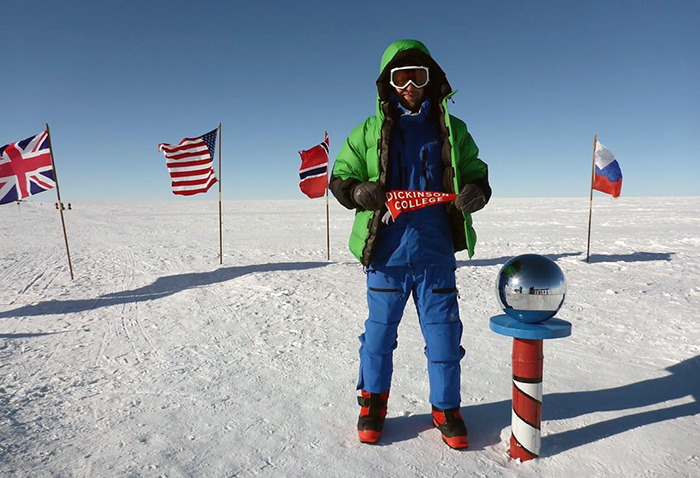
Cameron Kerr '09, a veteran and amputee, displays a Dickinson banner at the South Pole’s Amundsen-Scott Research Station.
Adventure raises awareness for preservation, sustainability, wounded warriors
by MaryAlice Bitts-Jackson
Antarctica is the world's coldest and most isolated continent. Trekking across its ice-sheeted expanse, you won’t find buildings or trees breaking up the horizon line. This time of year, there’s no sunrise or sunset—only broad daylight. And you may hear no sound but the biting wind, your own breath and your skis moving across ice and snow.
“It can mess with your head,” says former 1st Lt. Cameron Kerr ’09, a below-the-knee amputee who recently completed an eight-day, 60-nautical-mile journey to the South Pole, in -40-degree windchills. “Once your plane takes off and you’re just dropped in the middle of nowhere, you realize that things can potentially go wrong very quickly in all kinds of ways.”
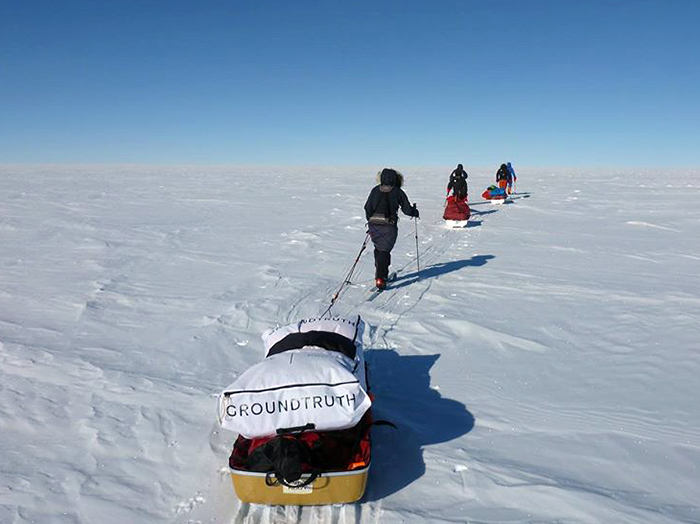
Because he needed to travel with an extra prosthetic--and equipment to make repairs, if needed--Cameron Kerr '09 carted an extra-heavy pack of roughly 60 pounds.
Kerr is a layman conservationist and Purple Heart recipient who lost his left leg in an IED explosion in Afghanistan in 2011 while checking on a wounded Afghan soldier. Less than a year later, he was snowboarding again, and he’s since run the Boston Marathon—twice!—and completed a 54-mile, 24-hour endurance hike in the Scottish Highlands. With funding from a Wounded Warrior grant, Kerr made his first trip to Antarctica in 2012, taking part in an expedition led by the 2041 Foundation, which seeks to raise awareness about the need to protect the Antarctic and an international mining-protection treaty that’s set to expire in 2041.
In November 2018, the organization’s founder, Robert Swan, invited Kerr to join him on a much more ambitious Antarctic adventure. “I hesitated for a quarter of a second,” Kerr says, “and then I said, ‘Absolutely!’ I’m always up for the next challenge.”
Exertion and reflection
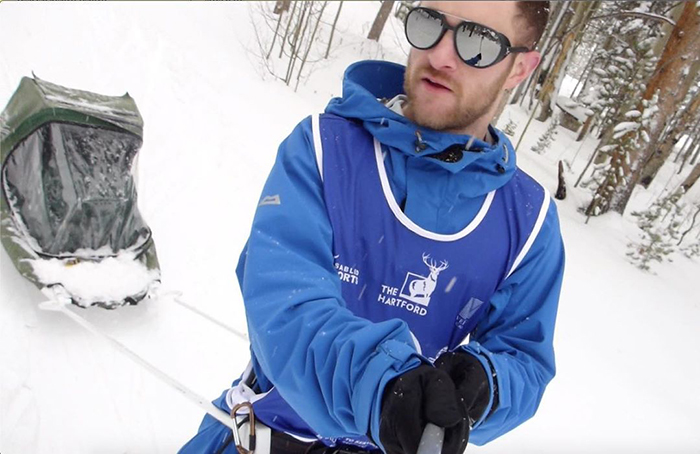
Cameron Kerr '09, during pre-expedition training at the Breckenridge Nordic Center, Colorado.
Swan, 63, is the first explorer to trek to both the North and South poles, and he wanted to complete the 600-nautical-mile, coast-to-pole crossing he’d begun in 2017 before a hip injury sidelined him. He and three others planned to meet Kerr and several other skiers at a point 60 nautical miles (110 kilometers) from the South Pole so they could travel together to the finish line. Kerr was the only wounded veteran on the expedition.
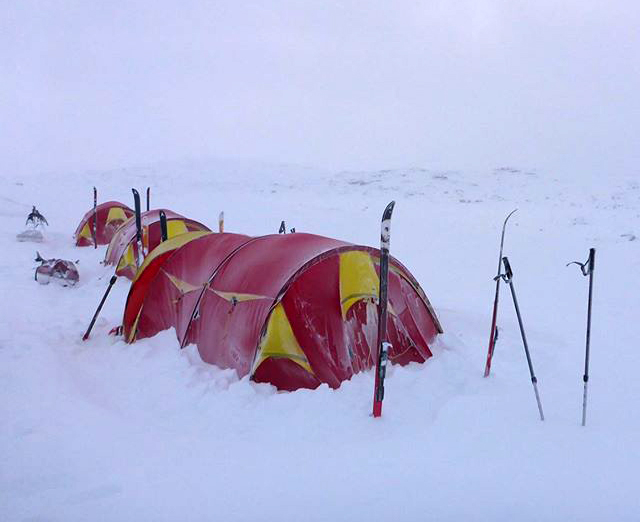
Kerr trained for the journey in Norway and met with an expert at Walter Reed National Military Medical Center to ensure that his prosthetic leg could perform well during daylong travels in the extreme cold—and that Kerr could make repairs along the way, if needed. Then he and his fellow travelers flew in a modified midcentury Douglas DC-3 plane from Union Glacier to the meeting point, at 89-degrees latitude. After getting used to the 9,000-feet-above-sea-level altitude, the team settled in for a 15-kilometer-a-day cross-country skiing schedule, stopping for 10 minutes each hour to hydrate (with melted snow) and refuel (with dried fruits, nuts and energy bars).
Skiing in bitter cold for seven hours a day—at that altitude and with some frostnip—wasn’t easy, especially with a heavier than usual sled, as Kerr had a backup prosthetic and related gear to carry. Even harder: the monotony. But Kerr didn’t listen to podcasts or music, opting instead to use his time to think deeply about why he was there.
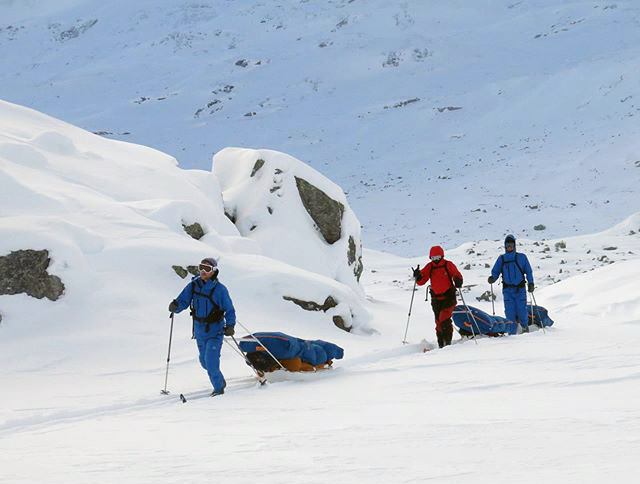
Cameron Kerr and a small team of skiers trekked in Antarctica to raise awareness about the need to protect the region from the effects of climate change and from mining. Above, Kerr trains for that trip in Colorado.
“Antarctica is one of the last places on Earth that’s untouched by humans, and getting to see it up close, you begin to really appreciate what that means, and what we have to lose if we don’t protect it,” he says. “And it’s the only continent that’s never seen human conflict. As a person who knows the ugliness of war very personally—and who carries the literal scars of war everywhere I go—that really resonates with me. It’s a place of science and exploration, peace, and international cooperation, and it needs to remain that way.”
Although a reinjured hip prevented Swan from making it to the finish line this time, the remaining team members reached the South Pole’s Amundsen-Scott Research Station as planned. Kerr flew the Disabled Sports USA flag and a Dickinson banner at the site.
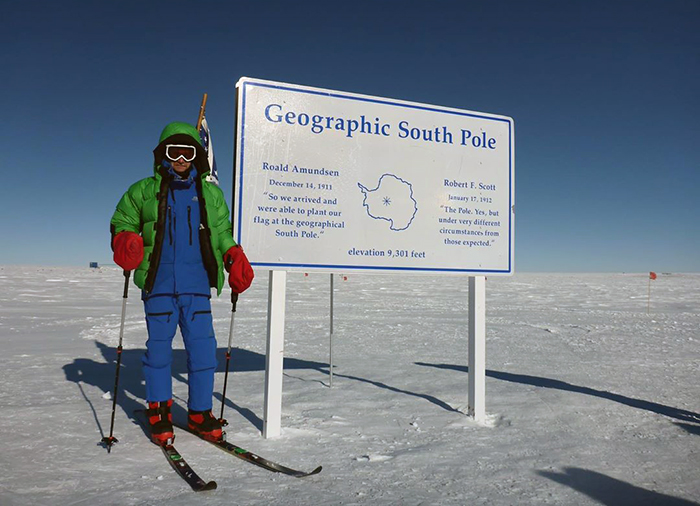
Kerr poses for a photo at the geographic South Pole. "It was humbling," he says, "because not many people have an opportunity to see that part of the world."
Spreading the word
Now, Kerr’s safely home in northern Virginia, in the sustainably constructed, highly energy-efficient tiny house he built, where he lives with his fiancée, Natasha. He works for The Explorer’s Passage, which leads sustainability-focused expeditions in support of Swan's 2041 mission, and he’s also involved with Disabled Sports USA as a Warfighter Sports Ambassador. Once home from the expedition, he shared observations and photos on dedicated Instagram and Facebook accounts, as part of his quest to spread the word about sustainability and Antarctic preservation as well as his experiences as an active wounded veteran.
In November, he’ll again join Swan in Antarctica—this time as an expedition leader.
“The mission of the expedition dovetails with Dickinson’s core values and ahead-of-the-curve sustainability focus,” he says. “We’re bringing a diverse, international team to Antarctica to experience and learn from the last great wilderness on Earth, and we’ll be training participants on climate science, sustainability and leadership skills so they can effect change in their communities, institutions and companies to benefit our planet.”
TAKE THE NEXT STEPS
Published February 21, 2020